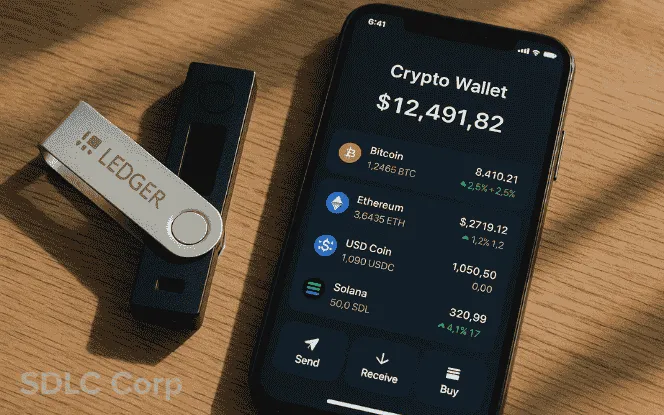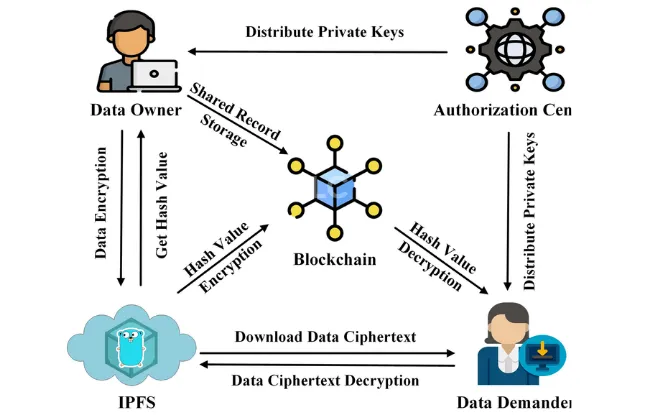Cryptocurrencies have changed how digital assets are stored, moved, and controlled. As a result, secure wallet solutions have become essential. Hardware wallets like Ledger are trusted because they isolate private keys and sign transactions offline. Recreating this level of protection in a mobile app is absolutely possible, but it requires a strong understanding of encryption, device security, blockchain networks, and transaction workflows.
A mobile wallet inspired by Ledger must be built with the same principles used by a crypto wallet development company strong isolation of private keys, strict security at every layer, reliable transaction signing, and smooth communication with multiple blockchains.
This guide explains all the important parts you need to build a Ledger-style cryptocurrency wallet app.
Understanding Ledger’s Core Security Model

Ledger is trusted because it handles security at every layer. To build a comparable app, developers need to implement the following pillars:
Ledger’s security strategy includes:
Multi-chain compatibility for Bitcoin, Ethereum, stablecoins, and emerging tokens
Isolated private key storage, kept offline on hardware
Secure transaction signing done within protected memory
PIN-based and biometric access control
Recovery phrase backups for restoring a lost wallet
A mobile app cannot replicate hardware chips directly, but it can follow the same principles using encrypted storage, secure enclaves, and safe signing methods within the device’s secure area.
Essential Features You Need to Build a Ledger-Style Wallet
To build a reliable wallet, your app must include every core feature found in modern crypto wallets.
1. Multi-Currency Support
Your app should support various networks and tokens, including Bitcoin, Ethereum, stablecoins, and EVM-compatible chains. This requires accurate blockchain integration for fetching balances, reading fees, and sending transactions.
2. Secure Private Key Storage
Keys must remain inside secure device storage. This is where mobile equivalents like Secure Enclave and StrongBox play the role of Ledger’s hardware chip. This approach is commonly used in blockchain app development.
3. Transaction Signing
Every blockchain transaction must be prepared, verified, and signed inside secure memory. The signed transaction is then broadcasted to the network without exposing private keys.
4. User Authentication
Add biometric unlock, PIN protection, and auto-locking. These layers prevent unauthorized access to the wallet.
5. Recovery Phrase Setup
Users must receive a seed phrase when creating a wallet. This backup ensures they can restore the wallet later.
Blockchain Integration Architecture
Getting a wallet to communicate with multiple blockchains is one of the most difficult parts of development. Each chain has its own set of rules, nodes, and transaction structures.

A good multi-chain architecture includes:
Communication with RPC endpoints (e.g., Ethereum JSON-RPC, Bitcoin nodes)
Token detection logic for ERC-20, BEP-20, and others
Gas estimation and fee calculation logic
Balance fetching and transaction history retrieval
Handling unstable or slow networks
Consistent error messages to guide users
This type of integration is often handled in advanced blockchain development services, where reliability and accuracy matter.
Secure Key Management (The Heart of the Wallet)
Private key protection is the most important part of any wallet application. Your entire app must be designed around keeping keys invisible and unreachable.
Good key management requires:
Generating private keys inside secure device hardware
Storing them encrypted with AES-256
Using Secure Enclave (iOS) or StrongBox (Android)
Preventing logs, backups, or screenshots from capturing sensitive data
Setting up seed phrase backups
Ensuring keys never leave the device
These techniques follow best practices commonly seen in cryptocurrency wallet development services.
Transaction Management and Signing
A wallet must handle the entire transaction lifecycle securely.
Here’s how a transaction flows inside a Ledger-style wallet:
The app prepares a transaction with the correct fields.
It verifies addresses, amounts, and network fees.
The transaction moves into secure memory.
The private key signs it without ever being exposed.
The app broadcasts it to the appropriate blockchain.
The network confirms it, and the status updates in the wallet.
Secure signing is critical because this is the moment where assets move. Many of the same techniques are used in crypto exchange development, where transaction integrity must be preserved.
User-Friendly Design and Experience
A secure wallet must also be easy to understand. Even advanced users appreciate simplicity.
Important UX considerations include:
A smooth onboarding process
Clear wallet creation steps
Simple instructions for handling seed phrases
Organized balance and asset views
Clean send/receive flow
Warning messages for unusual fees or invalid addresses
Easy navigation between tokens, NFTs, and histories
The more predictable the wallet feels, the safer users behave.
Recommended Technology Stack

A secure wallet can be built using native or cross-platform technologies:
Android: Kotlin
iOS: Swift
Cross-platform: Flutter or React Native
For blockchain communication, libraries such as web3.js, ethers.js, bitcoinjs, and Solana Web3 are commonly used. Backend services, if needed, rely on Node.js, Go, or Python.
Such full-stack security is also a part of strong custom software development services, where reliability is essential
Testing, Security Checks & Common Challenges
A cryptocurrency wallet requires a testing process that is deeper than regular mobile apps.
Critical tests include:
Seed phrase creation and restore tests
Transaction signing tests
Stress testing on multiple networks
Handling congested mempools
Penetration testing and vulnerability scanning
Ensuring keys never appear in logs
Device-specific behavior tests
Common challenges include inconsistent RPC nodes, network downtime, gas fee spikes, token detection issues, and user mistakes like entering wrong addresses.
A wallet must be prepared to handle all of these safely.
Conclusion
Building an app like Ledger is completely possible, but it demands careful design and strong security practices. From private key generation to blockchain connectivity and transaction signing, every part of the system must be engineered with precision.
While a mobile app cannot fully replace the physical isolation of a hardware wallet, secure enclaves, encryption, and offline signing allow a mobile wallet to achieve a high level of protection. When you combine these methods with clean design, reliable blockchain communication, and thorough testing, the result is a wallet app that users can trust for everyday crypto management.
Also Read Our New Blogs On.
Cost to Build an App Like Jahez: Complete Estimation Guide
Cost to Build an App Like WeChat: Features, Timeline, and Development Guide
Cost to Develop an App Like Klarna In 2025
FAQ'S
1. What makes a Ledger-style cryptocurrency wallet secure?
A Ledger-style wallet is secure because it isolates private keys from the internet, uses hardware-backed protection, and relies on strict cryptographic signing. A mobile wallet can follow similar methods by using Secure Enclave (iOS), StrongBox (Android), encrypted storage, and offline signing so that private keys never leave the device or appear in unprotected memory.
2. Can a mobile app be as safe as a hardware wallet like Ledger?
A mobile app cannot reach the same physical isolation as hardware, but it can achieve a high level of safety using device-based secure storage, strong encryption, biometric access, and offline signing workflows. When built correctly, a mobile wallet can protect private keys very effectively for everyday use.
3. How do cryptocurrency wallets generate and store private keys?
Wallets generate private keys using secure random number generators inside hardware-backed storage. The generated keys remain inside encrypted memory, protected by the operating system. They are never transmitted to servers or stored in plain files. This design ensures that only the device owner can authorize transactions.
4. What is a seed phrase, and why is it important?
A seed phrase is a 12–24 word backup that lets users recover their wallet if their device is lost or damaged. It represents the master key for all accounts. Because it can restore all assets, it must be protected carefully, stored offline, and never shared with anyone.
5. How does a crypto wallet connect to different blockchains?
Wallets communicate with blockchains using RPC endpoints, SDKs, and APIs. Each blockchain has its own protocol, so the app must format requests and interpret responses correctly. For example, Ethereum uses JSON-RPC, while Bitcoin uses UTXO-based structures. Proper integration ensures accurate balances and safe transactions.
6. How does transaction signing work in a Ledger-style app?
When a user sends funds, the wallet creates a transaction and moves it into secure memory. The private key signs the transaction inside this protected environment, and the signed data is broadcast to the network. The private key never leaves secure storage, reducing exposure.
7. What features should a modern crypto wallet include?
A modern wallet typically includes multi-chain support, real-time balance updates, NFT viewing, transaction history, price alerts, biometric authentication, and seed phrase backups. Some wallets also include watch-only modes or token swap features to improve usability.
8. What programming languages are used to build crypto wallet apps?
Most mobile wallets are built using Kotlin for Android and Swift for iOS. Cross-platform options like Flutter or React Native are also popular. Blockchain communication is handled using libraries such as ethers.js, web3.js, bitcoinjs, or specific SDKs from different blockchain networks.













